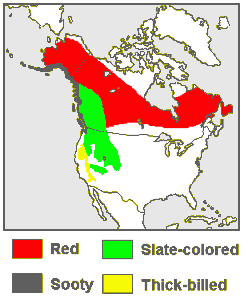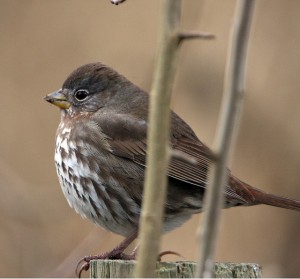Fox Sparrow, Part 1: Flight Calls
|
|
|
It’s late October — for many birders in the eastern United States and along the west coast, time for the Fox Sparrows to arrive from the north.
What arrives from the north, however, could be a bright rufous-red finch-like fellow, a slaty-gray and brown bird, or a dark chocolate-colored skulker, depending on what part of the country you’re in. These different-looking populations have been considered merely well-marked forms of a single species, Fox Sparrow (Passerella iliaca), at least as far back as Harry Swarth’s (1920) treatise, and the current generation of taxonomists, dominated by “splitters,” has so far left the species intact.

But several recent genetic studies (most notably Zink and Weckstein 2003) have provided evidence that four groups of Fox Sparrows have separate evolutionary histories and may deserve species rank:
- Red Fox Sparrow (iliaca/zaboria group), the brightest form, with strong reddish highlights in the wings, tail, back, and head, and strong reddish streaking below;
- Slate-colored Fox Sparrow (schistacea group), a high-elevation breeder with some rusty in the wings and tail, but otherwise primarily slate-gray, with little patterning on the head;
- Sooty Fox Sparrow (unalaschensis group), the darkest form, with little patterning on the head or wings;
- Thick-billed Fox Sparrow (megarhyncha group), which resembles the Slate-colored in plumage but, at least in the southern half of its range, sports a significantly bigger bill.
A 2000 paper in Birding by Kimball Garrett, Jon Dunn, and Robert Righter pointed out some differences in call notes between the groups that could have bearing on their identification and taxonomy. Although Don Roberson has created an invaluable in-depth online guide to visual identification of Fox Sparrow groups, I don’t know of any similarly comprehensive treatment of the calls — and so I figured it was time to treat this topic on Earbirding.
Among the many things that Fox Sparrow say are three major classes of calls: flight calls, alarm/position notes, and high-agitation “tsip” calls. We’ll start today with the flight calls and cover the others in a future post.
Flight call
The “flight call” of the Fox Sparrow is in fact often given by perched birds; it may indicate mild alarm, and it may sometimes be given as a contact call. It is typically a high-pitched, strongly underslurred, polyphonic “seet” or “suweet,” similar to the flight calls of Song and White-throated Sparrows (see this page by Paul Driver for more info on separating flight calls of sparrows from one another). The gurus on the flight call listserv often refer to “Song/Fox” sparrow flight calls, as the two can be difficult to tell apart in many cases.
All populations of Fox Sparrow give flight calls that are basically similar, but in my attempts to find examples from each population, I have turned up some interesting potential differences. Here is a side-by-side spectrographic comparison of flight call examples from across the continent:

All these examples can be heard online, but to make the composite spectrogram above I had to cull flight calls from the middle of many recordings I don’t have permission to remix, and some of the flight calls that appear right next to one another actually occur several minutes apart on these recordings, with other calls or songs in between.
- Call 1: Sooty Fox Sparrow flight call, Coos County, OR, 3/26/1989. Macaulay Library #44860
- Calls 2-5: Thick-billed Fox Sparrow flight calls, California, Macaulay Library #48832
- Call 6: Slate-colored Fox Sparrow flight call, Utah County, UT, 4/1/2000, Borror Lab #30600
- Calls 7-8: Slate-colored Fox Sparrow flight calls, Pierce County, WA, 9/22/2009, Xeno-Canto #39269
- Calls 9-12: Fox Sparrow flight calls from a bird matching the “Canadian Rockies” illustration in the Sibley Guide to Birds, Yuma County, CO, 12/28/2008. Recording by me; see also photos of this individual [1 2 3 4] courtesy of Bill Schmoker.
- Calls 13-14: Red Fox Sparrow flight calls, Osage County, OK, 3/21/2008. Recording by me.
- Calls 15-17: Red Fox Sparrow flight calls, Huntingdon Valley, PA, 11/1/2010, Xeno-Canto #69940.
Although I’ve placed them in the “Slate-colored” group per the recordist’s notes, I think it’s possible that calls 7-8 may actually pertain to the “Sooty” group — they are from the west side of the central Washington Cascades in late September, where Sooty is probably the more likely bird. In addition, both these two flight calls and the contact/alarm calls on the same recording are a closer match for other examples of Sooty Fox Sparrow than they are to calls of Slate-colored (more on contact/alarm calls next time).
If the Washington bird is indeed a Sooty, then the flight calls in the figure above would appear to fall into three similar but somewhat distinct groups:
- Sooty group (1, 7 & 8): High-pitched and deeply underslurred, with a strongly U-shaped trace on the spectrogram; note that the Oregon bird is giving the only single-voiced (not polyphonic) call of the bunch;
- Thick-billed/Slate-colored group (2-6): Lower-pitched, more shallowly underslurred, with a spectrogram like an open-mouthed smile;
- “Canadian Rockies”/Red group (9-17): High-pitched, strongly polyphonic, slightly burrier than other flight calls, and more strongly upslurred — note the tendency towards a “Nike swoosh” shape on the spectrogram.
If the Washington bird is a Slate-colored after all, then the deep U-shape may not be as distinctive a characteristic of the group as are the polyphony and the low pitch; if that’s the case and the above call by the Oregon bird is representative of Sooty Fox Sparrows everywhere, then Sooty may be the only group without a polyphonic flight call.
Overall, this is a pretty small sample size to make generalizations about, so if anyone can point me toward more examples of Fox Sparrow flight calls, particularly from the western groups, I’d love to see if the apparent patterns may hold. I’d also be glad of comments on the identification of the “Canadian Rockies” bird — it’s physically a pretty good match for the illustration in Sibley, but birds breeding in the Canadian Rockies should by all accounts fall into the Slate-colored group rather than the Red group. Why its flight calls appear to more closely resemble those of the Red Fox Sparrow group is not entirely clear.

